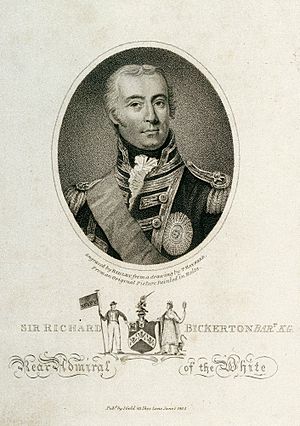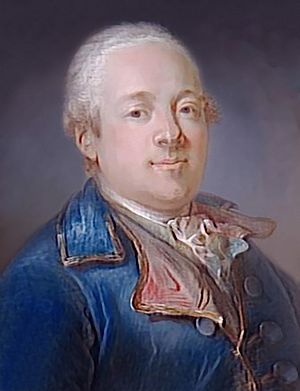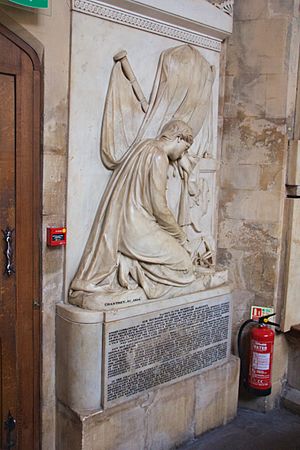Sir Richard Bickerton, 2nd Baronet facts for kids
Quick facts for kids
Sir Richard Bickerton
|
|
|---|---|
 |
|
| Born | 11 October 1759 Southampton, Hampshire |
| Died | 9 February 1832 (aged 72) Bath, Somerset |
| Allegiance | |
| Service/ |
|
| Years of service | 1771–1815 |
| Rank | Admiral |
| Commands held | HMS Invincible HMS Russell HMS Terrible HMS Amazon HMS Brune HMS Sibyl HMS Ruby HMS Ramillies HMS Terrible Portsmouth Command |
| Battles/wars | Fourth Anglo-Dutch War French Revolutionary Wars |
| Awards | Knight Commander of the Order of the Bath |
Sir Richard Hussey Bickerton (born October 11, 1759 – died February 9, 1832) was a brave British naval officer. He was born in Southampton, England, and followed in his father's footsteps, who was also a Vice-admiral. Richard Bickerton started his naval journey at a young age and rose through the ranks to become a full Admiral. He fought in important wars like the Fourth Anglo-Dutch War and the French Revolutionary Wars. He was known for his leadership and for working alongside famous admirals like Lord Nelson.
Contents
Early Life and Family
Richard Bickerton was born in Southampton on October 11, 1759. He was the only son of Vice-admiral Sir Richard Bickerton and Mary Anne Hussey.
In 1788, he married Anne Athill. When his father passed away in 1792, Richard became the 2nd Baronet. This meant he inherited his father's title. He was also chosen to be a Fellow of the Royal Society in 1810. This is a special group for people who have done great things in science. In 1815, he was made a Knight Commander of the Order of the Bath, a high honor. Later, in 1823, he added his mother's maiden name, Hussey, to his own.
Richard Bickerton joined the Royal Navy when he was just 12 years old, in December 1771. Even though he was listed on his father's ships, he didn't actually start serving until June 1774. He began his real service on HMS Medway as a captain's servant. He quickly moved up, becoming a midshipman. He served in the Mediterranean Sea before returning home in 1777.
Becoming a Commander
Bickerton was promoted to lieutenant in December 1777. He served on several ships, including HMS Prince George. In 1778, he joined HMS Jupiter. His captain, Charles Middleton, thought highly of him.
In October, Jupiter bravely attacked a much larger French ship, Triton, and forced it to retreat. Because of his excellent actions, Bickerton was promoted to master in March 1779. He was given command of the sloop, HMS Swallow. He spent almost two years on Swallow, protecting convoys and cruising in The Channel. One time, he quickly ordered a convoy to scatter when he heard a large enemy fleet was coming. This smart move helped the convoy escape. After helping capture a Dutch convoy, Bickerton and his ship were sent to the West Indies. There, he joined Rodney's squadron and helped in the capture of Sint Eustatius in 1781.
Rising to Post Captain
Rodney promoted Bickerton to the rank of post captain on February 8, 1781. He was given temporary command of HMS Invincible. On this ship, Bickerton took part in the Battle of Fort Royal in April 1781, off the coast of Martinique.
Soon after, he got his own ship, HMS Russell. He later moved to the frigate, HMS Amazon. After serving in the Leeward Islands and North America, Bickerton returned to England in 1782. He commanded HMS Brune for a short time before being without a ship. In 1787, he took command of HMS Sibyl and sailed back to the Leeward Islands.
French Revolutionary War Service
When France declared war in 1793, Bickerton was given command of HMS Ruby. He served in The Channel before moving to HMS Ramillies in 1794. He then helped transport General Sir John Vaughan to the West Indies. General Vaughan was going to take command of the British land forces there.
Bickerton stayed in the West Indies until 1795, then went to Newfoundland. He returned home in November 1795 and joined Admiral Adam Duncan's fleet in the North Sea. He served under Duncan for a year, then moved to the Channel Fleet. In 1798, Bickerton took command of the new HMS Terrible. Later that year, he became a Colonel of Marines. In February 1799, Bickerton became a rear-admiral. Towards the end of the year, he became the Assistant Port Admiral at Portsmouth.
Service in the Mediterranean
In May 1800, Bickerton sailed on Seahorse to transport important generals to the Mediterranean. He spent the rest of the war there, helping to block enemy ports. In June, he took command of a squadron off Cádiz. In 1801, he worked on HMS Kent, keeping a blockade on the port of Alexandria until it surrendered in August. He provided important support to the army during this time.
Bickerton was left to oversee the French forces leaving Alexandria. He did this so well that he earned the respect of the French general, Jacques-François Menou. General Menou even said that Bickerton's squadron had helped speed up the surrender of the city by cutting off their supplies. For his part in the British victory, the Turks gave Bickerton the Order of the Crescent in October 1801. After a short period of peace, Bickerton remained in command of the Mediterranean Fleet.
Napoleonic Wars and Later Career
By 1804, Bickerton was still in the Mediterranean, serving as Second-in-Command to Admiral Lord Nelson. They kept a close watch on the French port of Toulon. When Nelson was honored by the City of London, he insisted that Bickerton receive the same recognition. Bickerton became the top commander in the Mediterranean when Nelson left to chase the French Fleet across the Atlantic Ocean.
In 1805, Bickerton had to return to England because of illness. He was promoted to vice-admiral in November 1805. He then joined the Board of Admiralty in 1807, which helps run the Navy. In May 1808, he became the First Naval Lord, a very important position. On July 31, 1810, Bickerton became a full admiral. In March 1812, he left the Admiralty Board and became the Commander-in-Chief, Portsmouth. This meant he was in charge of the important naval base at Portsmouth.
Bickerton was still in this role in 1814 when a big naval review, called a Grand Naval Review, was held at Spithead to celebrate the end of the war. This was his last active service. He was made a Knight Commander of the Order of the Bath (KCB) in January 1815. He was also promoted to Lieutenant-general of the Marines in 1818, and then General of the Marines in 1830.
Political Career
Bickerton was elected as a Member of Parliament (MP) for Poole in February 1808. This meant he helped make laws for the country. He was a Conservative, but he didn't often speak in Parliament. When he did, it was usually about naval issues. He did not run for re-election in 1812.
Death and Legacy
Sir Richard Bickerton passed away at his home in Bath on February 9, 1832, at the age of 72. His wife lived longer than him. Since they did not have any children, his estate went to his wife's nephew. Because he had no male children, his baronetcy title ended with his death.
A memorial for Bickerton was put up in Bath Abbey in 1834. Also, Bickerton Island off the east coast of Australia's Northern Territory was named after him. This was done by the famous British explorer, Matthew Flinders, who sailed around Australia.



